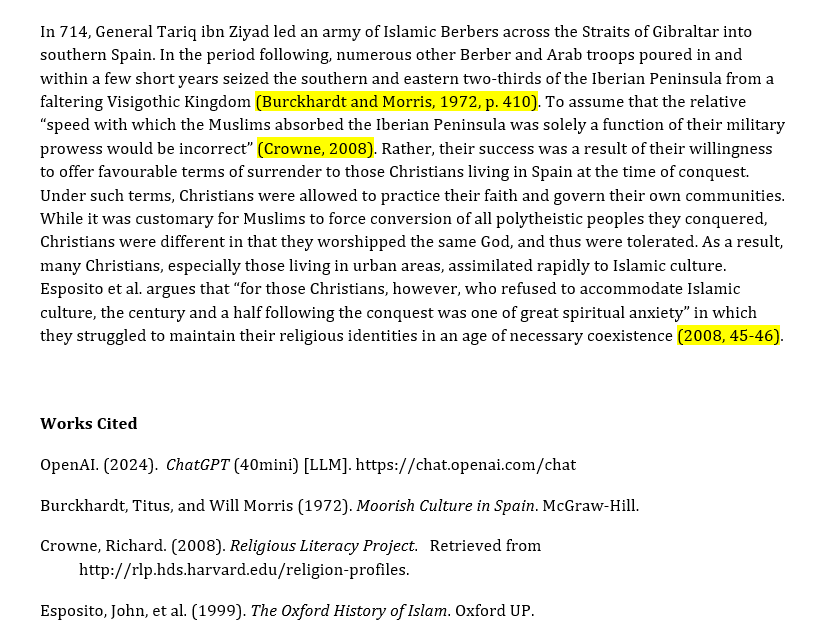APA (American Psychological Association) guidelines are commonly used in math, science, and social-science courses to enable others to easily understand and check sources.
If you are using these APA guidelines for a paper, then you must use both In-Text Citation and a Works Cited List. Both are explained below.
Note: APA Works Cited and Bibliography are not the same. In Works Cited you only list items you have actually cited. In a Bibliography you list all of the material you have consulted in preparing your essay whether or not you have actually cited, summarized, or paraphrased the work.
Sample:
In the following short sample of APA citation, the in-text citations are highlighted for you to easily notice. You wouldn't highlight citations in your paper.

This sample is based on explanations from https://guides.library.uwa.edu.au/
In-Text Citations (included throughout your paper):
In-text citations are used throughout your paper for:
-
-
- A fact that is not common knowlege.
- A quote.
- Paraphrasing or summarizing ideas that are not your own.
- Paraphrasing or summarizing research that is not your own.
- Statistics that you didn't establish.
-
NOTE: In-text citations include sources that are trusted in the facts that you are citing. Thus, ChatGPT (or other AI sources) are NOT to be used for in-text citations. If an AI souces gave you some ideas, be sure to list the AI model in the Works Cited below, then do research to use a more trusted source for your in-text citation where the related facts or quotes are discussed.
Works Cited List (at the end of your paper):
Here is a list of sample citations for a few of the most commonly used resources.
-
-
- "Works Cited List" must include all of the works that have contributed ideas and information to your essay (through direct quotation, summary or paraphrase).
- List sources alphabetically, according to the surname of the author.
- If a source has no author, alphabetize it by its title (not THE or A/AN).
- With a source with multiple authors – the first name in the list is the only one with the last name first – all others are first name then last name.
- Indent every line of a citation after line #1 in each reference (a hanging indent).
- Double space all citations (examples below are single, to save space on this explanation page)..
-
| Artificial Intelligence Source (eg. ChatGPT) |
|
Author. (Date). Name of Tool (Version) [LLM]. URL OpenAI. (2024). ChatGPT (40 mini) [LLM]. https//chat.openai.com/chat |
| A Book with author or corporate author |
|
Author, A. A. (Year of publication). Title of work: Capital letter also for subtitle. Location: Publisher. Calfee, R. C., & Valencia, R. R. (1991). APA guide to preparing manuscripts for journal publication. Washington, DC: American Psychological Association. * Note: For "Location," you should always list the city and the state using the two letter postal abbreviation without periods (New York, NY). *When a book has multiple authors, order the authors in the same way they are presented in the book. |
| Periodicals |
|
Periodicals include magazines, newspapers, and scholarly journals. *APA style dictates that authors are named last name followed by initials; publication year goes between parentheses, followed by a period. The title of the article is in sentence-case, meaning only the first word and proper nouns in the title are capitalized. The periodical title is run in title case, and is followed by the volume number which, with the title, is also italicized. If a DOI has been assigned to the article that you are using, you should include this after the page numbers for the article. If no DOI has been assigned and you are accessing the periodical online, use the URL of the website from which you are retrieving the periodical. Author, A. A., Author, B. B., & Author, C. C. (Year). Title of article. Title of Periodical,volume number(issue number), pages. https://doi.org/xx.xxx/yyyy Henry, W. A., III. (1990, April). Making the grade in today's schools. Time, 135, 28-31. |
| An Entire Website |
|
When citing an entire website, follow the format below. Last, F. M. (Year, Month Date Published). Article title. Retrieved from URL Cain, K. (2012, June 29). The Negative effects of Facebook on communication. Social Media Today RSS. Retrieved from http://socialmediatoday.com |
| A Single Webpage |
|
Individual webpages and documents hosted online are cited similarly to print content. Note, however, that the URL is typically included at the end of the entry. The URL may, at the author's discretion, be left as an active link. Include additional information (like translators, editors, first edition publication date, and so on) as you would for print sources. Author, A. A. & Author B. B. (Date of publication). Title of page [Format description when necessary]. Retrieved from https://www.someaddress.com/full/url/ Eco, U. (2015). How to write a thesis [PDF file]. (Farina C. M. & Farina F., Trans.) Retrieved from https://www.researchgate.net/...How_to_write_a_thesis/.../Umberto+Eco-How+to+Write+... (Original work published 1977). |
| A Blog Post |
|
Last, F. M. (Year Month Date Published). Article title [Type of blog post]. Retrieved from URL. Kirschenbaum, M. (2017, January 4). 10 ways to spot a fake news article [Blog post].Retrieved from /10-ways-to-spot-a-fake-news-article/ |
| Online Images |
|
Photographer, F.M. (Photographer). (Year, Month Date of Publication). Title of Photograph [digital image]. Retrieved from URL O’Shea, P. (Photographer). (2010, August 29). Rescued hedgehog [digital image]. Retrieved from http://flickr.com/photos/peteoshea/5476076002/ |
